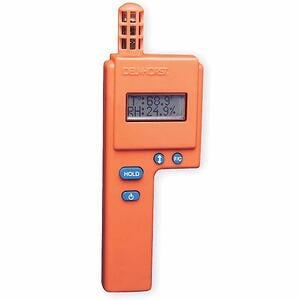 Thermo-hygrometers are useful and accurate tools that measure the relative humidity (RH) in concrete slabs as well as the RH and temperature of ambient conditions in a hardwood flooring installation. Accurate performance and consistent readings of rugged thermo-hygrometers are pivotal for maintaining the integrity of any construction project. Fortunately for construction professionals using thermo-hygrometers, there are some easy ways to keep these meters in good working order for years to come.
Thermo-hygrometers are useful and accurate tools that measure the relative humidity (RH) in concrete slabs as well as the RH and temperature of ambient conditions in a hardwood flooring installation. Accurate performance and consistent readings of rugged thermo-hygrometers are pivotal for maintaining the integrity of any construction project. Fortunately for construction professionals using thermo-hygrometers, there are some easy ways to keep these meters in good working order for years to come.
Proper Care
Perhaps more than any other factors, getting the most accurate RH readings involves proper thermo-hygrometer care, Aging sensor upkeep, proper calibration, and protection from outside chemicals or materials are necessary to maintain the accuracy of the meter’s performance.
There are numerous common construction elements that may harm thermo-hygrometers and disrupt calibration, including PVC, acetate and polystyrene. A sturdy protective covering can minimize the potential for contaminants, chemicals and dirt that could harm your meter’s sensors. Extreme chemical exposure can permanently damage thermo-hygrometers in hours, and affect meter sensitivity by interacting with a sensor’s polymer material.
Maintaining your meter’s calibration is important for consistent and accurate RH readings. Performing simple maintenance can do much to keep your meter accurately calibrated, such as:
- Proper storage and a stable environment.
- Testing sensors using a salt solution, to verify calibration.
- Setting aside a secondary, reference sensor to compare readings taken on the sensor used in the field.
Maintaining and verifying a thermo-hygrometer’s calibration is key for success, as proper meter calibration can make or break entire construction and restoration jobs.
Efficient use, proper maintenance and calibration monitoring can keep your RH readings accurate, as well as ensuring that your meter is running effectively, for years of future use and success.
The Pivotal Role of Accurate Readings
Appropriate care and maintenance of your thermo-hygrometer helps ensure accurate readings that are so critical in many construction jobs. Inaccurate or faulty RH readings can result in voided flooring, coatings and adhesives manufacturers’ warranties, and halt operations for large chunks of precious time. By keeping the accuracy of their thermo-hygrometers consistent and correct, construction professionals can avoid the hassles of voided warranties and contractual obligations, and keep their projects moving along.
Knowing how to keep your durable thermo-hygrometer running effectively requires a thorough understanding of the way these tools work. Understanding the sensing components of thermo-hygrometers, and how to set and maintain appropriate calibration, is the most logical first step toward getting the most out of your thermo-hygrometer.
If you are interested in learning more about how to keep your relative humidity meter performing with consistent accuracy, or want to learn more about what these meters can do for your construction projects, contact us today. Our humidity and moisture detection experts will help you find the right tools you need for the job.

Comments